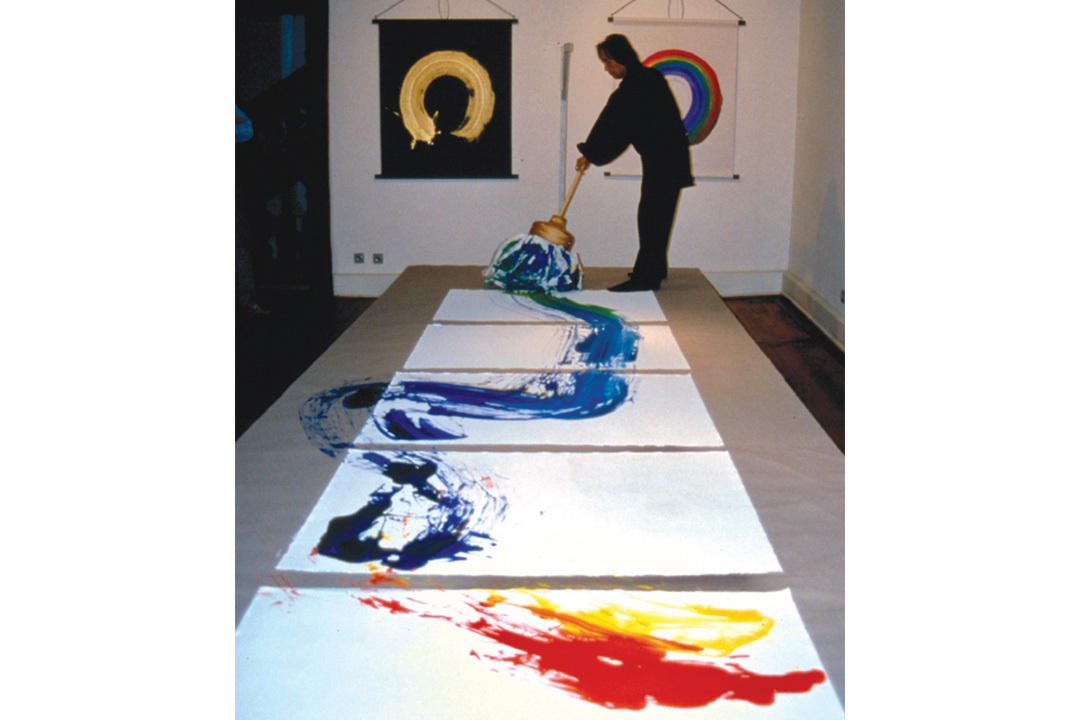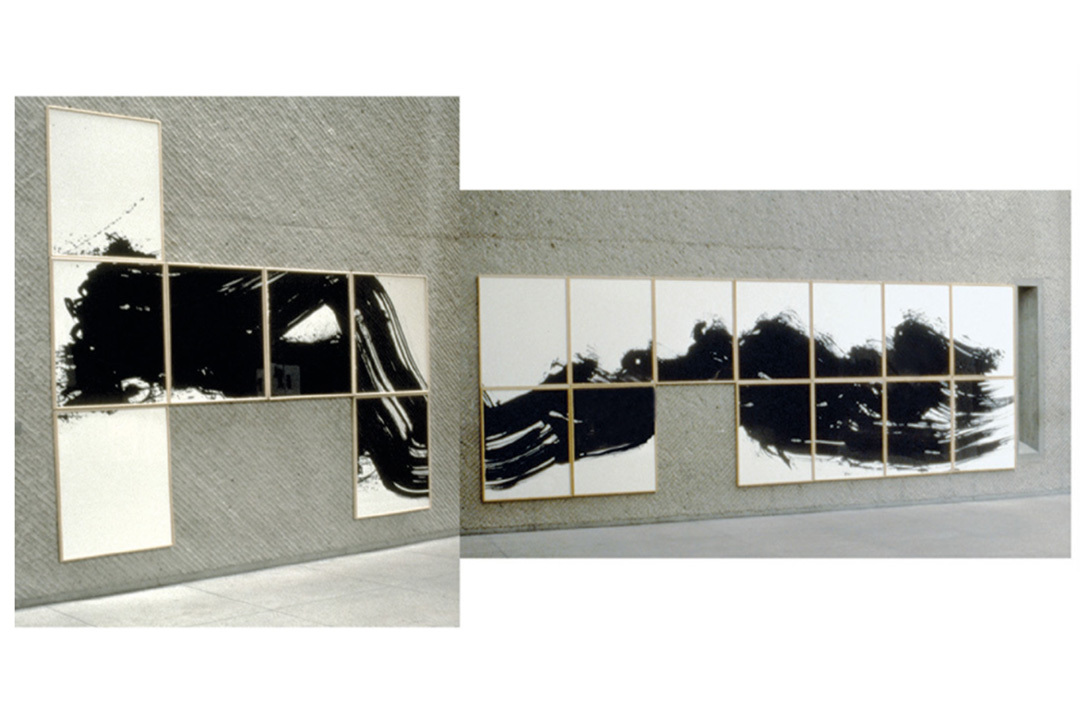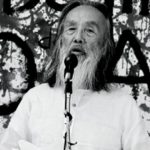A Dream—and a Once-in-a-Lifetime Joke
The idea came to me of doing the entire exhibition in one stroke.
Can we recycle as Nature does? by Kazuaki Tanahashi
In January 1987, the coordinator of exhibits at the Cathedral of Saint John the Divine in New York invited me to exhibit my work in November in its Chapel of Saint Boniface. At that point, I defined my one-stroke painting as “a painting created in one breath in a single brushstroke, straight or curved.” I had created the genre in San Francisco a few years earlier, and it may be described as emerging from East Asian calligraphy, with influences from Jackson Pollock, Franz Kline, and my own lazy nature. I was overjoyed by the cathedral’s invitation.
I thought of the exhibition as a once-in-a-lifetime joke of mine, since a Gothic cathedral and one-stroke brushwork seemed to be extreme opposites of artistic creativity. While the cathedral’s construction started almost a century ago and is still going on, one-stroke painting often takes minutes or even seconds. But beyond this comparison, I wanted to touch upon the deeper meaning of the cathedral so that it would help me to explore a new realm in my art. In order to do so, I needed to ponder why people take such an enormous amount of time and energy to build a structure like this.
Surrender was the word that arose and stayed with me. The word first struck me when I heard Mother Teresa use it in a TV documentary. Wouldn’t we need to give up many of our expectations and desires to be a part of the generations-long effort of building a cathedral? In our daily life we are often forced to surrender to “stupid” things like traffic jams, unexpected bills, or illness. Wouldn’t it be more worthwhile to surrender to a higher value? What might that value be? I decided that I wanted to surrender to the unknown, vast and sacred.

Creating Where Are We Going?
When Mother Teresa spoke of surrender to God, I was reminded of the Buddhist notion of selflessness. According to this teaching, we have no permanent self, no lasting possession. It is therefore important to develop a sense of freedom from attachment to possessions, including one’s view of oneself. Such an understanding is central to my art: My life as an artist has been a process of giving up. I abandoned concrete forms, then colors, shades, composition, nuance, refinement, the attempt to please, as well as the use of a seal or signature. But the last fortress I was holding on to was a certain aesthetic judgment. Now I wanted to get rid of that (at least for some time). Would the work still be art? I was not sure.
Reflecting on how brushes work, I realized that all brushes are made to create consistently even results.
This was exactly what I did not want.
Thus an idea came to me of doing the entire exhibition in one stroke—a method that would enable me to let go of values and judgments to a large extent. Then, I decided to build two giant brushes to do justice to the scale of the world’s largest work of Gothic architecture. Why two brushes? Because I have two hands.
The design process and the search for materials started in June 1987. Each brush would be seventy-five inches long, with “bristles” thirty inches long and ten inches in diameter. I found a wood turner to help build a handle and base for the brushes. He laminated poplar boards and made a bowl-like shape to contain the top base of the bristle. According to my estimate, half a million strands of shark fishing line were enough to make the bristle for one brush. After a long delay, spools of nylon thread arrived two weeks before October 9, the day I had set up to do the artwork in the presence of several friends I had invited. To my disappointment, the volume of the nylon thread was too small. It turned out that ten million threads would be needed for the dimension I had in mind. There was no time to reorder and rewind such a large quantity of thread.
Reflecting on how brushes work, I realized that all brushes are made to create consistently even results. This was exactly what I did not want. Rather, I needed brushes that would form different landscapes here and there in the picture within a simple line. What I was looking for was a brush of odd performance. I wrapped reeds with long strips of white felt, then added a bunch of foam rubber, cotton ropes, and raffia to them.

Surrender - Kazuaki Tanahashi
It only took about four minutes to do the entire stroke, but it took three hours to suck up puddles of extra ink on the painted panels with a wet-dry vacuum cleaner.
On October 8, I was going to create four paintings with one of the brushes to test how it would perform. I poured three gallons of sumi (charcoal) ink into a metal basin. Of course, many bottles of liquid ink were used, as it would have taken months to grind ink sticks in a traditional way on an inkstone to get that amount of ink. When pitch-dark ink was absorbed into the “bristle,” the brush was almost impossible to lift. As we usually don’t think of the weight of ink, it was a rather strange realization—a certain amount of ink could strain one’s back.
The living room of our house in Berkeley, California (where we had moved in 1986), was emptied out. Some plastic drop cloths and craft paper covered the floor as well as parts of the walls. Twenty white mat boards, 32 by 40 inches, numbered on their backs, were laid out next to one another. The only requirement I had for this set of paintings was that every piece should be substantially different from every other. That meant the position and direction of the brush should be unique on each panel.
I had not prepared any sketches. But for some months before this event, I woke every morning around 3:00 and, lying in bed, visualized creating large single strokes over and over again behind my dozy eyes. This reminded me of a love poem I had written in a traditional Japanese 31-syllable form, a waka, 20 years before:
Again,
again, and
over again—
picturing in my heart.
Erasing and picturing.
It seemed as if this poem had been a prediction of my current nighttime routine.
Carrying one of the brushes from the basin to a position above the paper was like skating with an armful of dripping laundry. I practically threw the brush onto the paper so that splashes of ink would reach the first three sheets before the brush touched them. It felt like mud fights in my childhood, when we kids got out of control and smashed lumps of mud on each other’s faces.
Friends spontaneously started chanting in deep voices, “Surrender, surrender…” I laughed and dragged the wet brush while twisting it. The brush was doing a fair job of reflecting in its complex traces all the confusion in my mind. After some moments the brush movement slowed almost to a standstill while the photographer changed film. Soon I picked up the other brush and started pushing both of them together with all my might, wondering why intensity was at the same time so relaxing. It only took about four minutes to do the entire stroke, but it took three hours to suck up puddles of extra ink on the painted panels with a wet-dry vacuum cleaner.
The morning after using these brushes—probably the largest in the world—Linda handed me a note from Paul Maurer, an artist and brush maker living in Pennsylvania, whom I had met at a calligraphy conference in Portland. He wrote: “It was nice to work with you. Thank you for letting me use your large horsetail brush. I am sending you a small brush for a change.” In the envelope there was a brush with an elderberry-branch handle. The bristle was about two inches long—made of six strands of cat’s whiskers.
From Painting Peace by Kazuaki Tanahashi © 2018 by Kazuaki Tanahashi. Reprinted by arrangement with Shambhala Publications, Inc. Boulder, Colorado. www.shambhala.com


